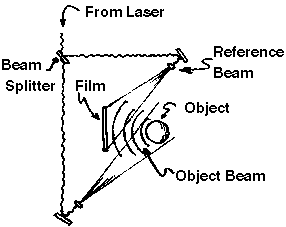
Producing high quality holograms is a complicated process. In the simplest terms, a hologram is made by splitting a high-powered laser into 2 beams: an object beam, which bathes a 3-dimensional object, and a reference beam, which illuminates the film from a different angle. The light waves reflected from the object and the waves from the reference beam overlap to form whatís called an interference pattern on a special high contrast, very fine grain photographic film. When this film is developed and illuminated, the original object is recreated as a fully three-dimensional image.

Why a laser?
The most important part of the hologram is the interference pattern of light. In order to set up a clear interference pattern, the light waves used must be in-phase, or coherent. Most light, such as sunlight or the light from a light-bulb, is incoherent. This means that the bundles of light are not all lined up, so that the number passing a given point at a given time varies constantly. However, laser light is coherent; its photons are in-phase. To understand what these categories mean, imagine a typical freeway with cars passing through a tunnel. A typical stream of random cars would resemble an incoherent beam of light. However, if all of the cars were identical, were lined up, and were moving at exactly the same speed, the freeway would resemble a coherent beam of laser light. The coherence of the beam allows the overlapping of differing beams to set up a consistent interference pattern, which leads to a clear image.

So why does a flat hologram appear 3-dimensional?
Since we have stereoscopic vision, our brains are used to interpreting two images of an object from slightly different angles as a 3-dimensional object (For more information on vision, click ADD LINK here). Basically, a hologram provides the brain with two images of an object from slightly different angles. When these images are displayed to each eye separately the brain believes that it is seeing a 3D object.
Actually, this is a vast oversimplification of what is really at work in a hologram. In fact, a hologram acts like a very complex lens through which each of the infinitesimally small points on the object that reflected light onto the film, by interfering with the reference beam, are neatly focused to their respective positions in 3-dimensional space, but to explain exactly how this is accomplished is beyond the scope of this overview.
|
| ||
BACK |
|
NEXT |